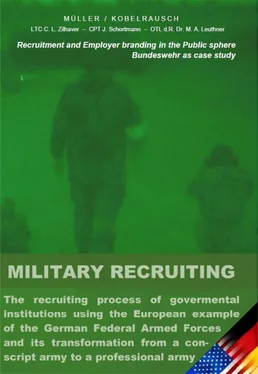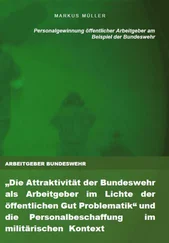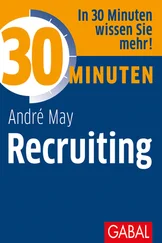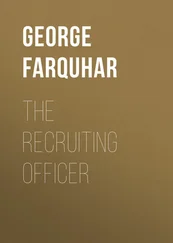5.3 Limitations and further research horizon
List of references
List of other sources
List of legal sources
List of abbreviations
| a. w. |
alternative view |
| ANOVA |
Analysis of Variance |
| Art. |
Article |
| b |
standardized regression (beta) coefficient |
| BbesG |
Bundesbesoldungsgesetz - Federal Civil Service Remuneration Act |
| BMBF |
Bundesministerium für Bildung und Forschung - Federal Ministry of Education and Research |
| BMVg |
Bundesministerium der Verteidigung - Federal Ministry of Defence |
| BW or Bw |
Bundeswehr |
| CA |
Corporate Attractiveness |
| CC |
Corporate culture |
| cf. |
compare |
| CB |
Corporate Branding |
| DBwV |
Deutscher BundeswehrVerband - German Federal Armed Forces Association |
| CC |
corporate culture |
| DEBA |
Deutsche Employer Branding Akademie - German Employer Branding Academia |
| div. |
diverse |
| DPO |
Diplom Prüfungsordnung - Examination Regulations for Diplom |
| EA |
Employer Attractiveness |
| EB |
Employer Branding |
| Ed. |
Editor |
| Eds. |
Editors |
| eg |
for instance |
| EI |
Employer Image |
| EStG |
Einkommensteuergesetz - German Income Tax Act |
| et al. |
et alia: and others |
| EU |
European Union |
| EVP |
Employee value proposition |
| Fig. |
Figure |
| Ger. |
Germany |
| GG |
Grundgesetz - German constitution (Basic Law) |
| GPG |
global public good |
| HR |
Human resource |
| HRM |
Human Resource Management |
| i.a.w. |
in accordance with |
| i.c.w. |
in conjunction with |
| IAB |
Institut für Arbeitsmarkt- und Berufsforschung - Institute for Employment Research of the Federal Employment Services |
| KWKG |
also as KrWaffKontrG; Gesetz über die Kontrolle von Kriegswaffen - War Weapons Control Act Law |
| KYC |
know your customer principle |
| N |
number of participants / scope of the survey |
| NATO |
North Atlantic Treaty Organization |
| NRF |
NATO Response Force |
| OLS |
Ordinary-Least-Squares-Model (Estimation model based on the least squares or MKQ-model) |
| Pub. |
Publisher |
| PS |
public service |
| PSM |
Public Service Motivation |
| pur. |
Pursuant to |
| Sig. |
Significance |
| SPSS |
Statistical Package for the Social Sciences |
| u.a. |
und andere – and others |
| VdRBw |
Verband der Reservisten der Deutschen Bundeswehr – Reservist Assoziation of the German Armed Forces |
| w. appl. |
where applicable |
| WehrRÄndG |
Wehrrechtsänderungsgesetz – Military Change Act Law |
| WLB |
Work-Live-Balance |
List of tables and figures
Figure 1: Pure and impure public goods
Figure 2: Public goods in conflict with private goods, externalities and global public goods
Figure 3: Prisoner's dilemma
Figure 4: Procedural representation of a State conflict prevention strategy
Figure 5: Table for generations’ age groups
Figure 6: Scenarios for the development in the labor force by 2050; Fuchs et al. (2011)
Figure 7: Age structure of the labor force potential by 2050; Fuchs et al. (2011)
Figure 8: Timeline of-career extended by the military recruitment component
Figure 9: Employer Branding as Trinitas
Figure 10: Advanced Phase model in behavioral theoretical framework 42 (self-created)
Figure 11: Model 47 of employer attractiveness as part of the corporate attractiveness
Figure 12: Components of the work-life balance (Stock-Homburg, 2008) and detail of the questions of work-life balance monitor for early detection of stressors
Figure 13: Typology of managers in dealing with their work-life balance (Stock-Homburg, 2011)
Figure 14: Base salary of soldiers and officials in Grade A
Figure 15: Gross monthly salary (excluding bonuses) according to university degree
Figure 16: Attractiveness of selected employers by gender
Figure 17: Integrated Model of job choice (Malmendier, 2006)
Figure 18: Overview of the armed services of the armed forces
Figure 19: German soldiers differentiated according to the status of their service
Figure 20: Gender-specific proportion of subjects
Figure 21: Distribution by gender-adjusted subjects ages
Figure 22: Educational level within the group of subjects
Figure 23: Primary age-cluster of the participant scope
Figure 24: Overview of the analyzed variables
Figure 25: Perception of employer Bundeswehr (three single occurrences)
Figure 26: Assessment of the Bundeswehr (general)
Figure 27: Correlations of instrumental variables (analysis stage 1)
Figure 28: Correlations of all variables (analysis stage 2)
Figure 29: Summarized linear regression model analysis on stage 1, 2 and 3
Foreword
The study on "Military Recruiting" explores the complexities of military recruitment and presents them in a global economic science context. It is not only a primary scientific study on employer attractiveness of state institutions on the example of the German Federal Armed Forces, offering a comparison with other European armies and the US military, but covers the theme of employer branding from work-life balance to global economic aspects. For the implementation of the results the two levels of internal and external influencing factors that affect the choice of the employer were determined: "instrumental dimension (objective (pre-) knowledge)" and "symbolic dimension (subjective emotions)".
The original German-language publication "Bundeswehr as an employer" (see Müller, 2014 and Drevs, Müller, 2015) expanded [ISBN 978-3-8442-9474-3 / (e) ISBN 978-3-8442-9723-2] adds to the recent research on employer attractiveness of state institutions and describes for the first time conclusions of the transformation from a conscript army to a professional army based on primary data. With universal applicability the extended "phase model of employer-employee interaction in a behavioral theoretical framework (Process of perception of a company as to employer and the steps of Interaction)" describes these contexts broader than the existing models could have been done before and discusses approaches accessing both opposite strands of development and parallel structures. The original German work can already be found in various scientific libraries, military archives and European research institutions.
A particular intention of this work is to show how scientific research in civil-military context and civilian use may not only complement each other but also constitute an interdependent benefit extension. The core study covers not only "The attractiveness of the Bundeswehr as an employer in the light of the public good problem" and the recruitment in the military context, but also recruiting in general. Under this approach the Bundeswehr is exemplified as a state institution in the research focus of the recruitment of public employers. The analytic approach, the found correlations and implications may serve as a basis for public employers and government as well as for private companies. For this purpose, individual topics were embedded as self-contained subject areas (see Table of Contents and List of Figures) in the overall context. Beyond that, general government and policy-making aspects such as the provision of public goods problem and geopolitical issues like the establishment of global public goods have been addressed with the understanding of the attached security concerns to sufficient degree.
Читать дальше












